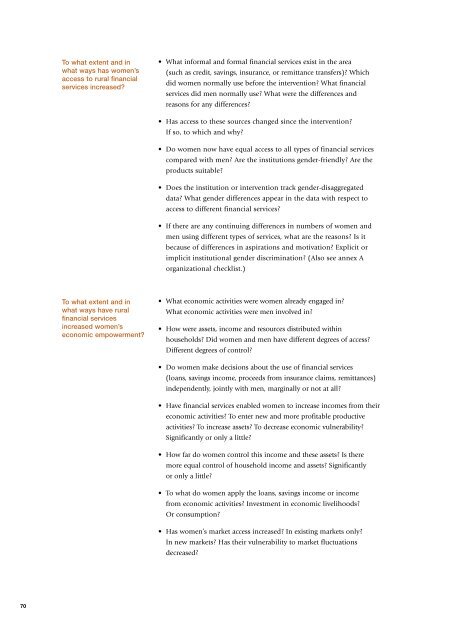Gender and rural microfinance: Reaching and empowering ... - IFAD
Gender and rural microfinance: Reaching and empowering ... - IFAD
Gender and rural microfinance: Reaching and empowering ... - IFAD
Create successful ePaper yourself
Turn your PDF publications into a flip-book with our unique Google optimized e-Paper software.
To what extent <strong>and</strong> in<br />
what ways has women’s<br />
access to <strong>rural</strong> financial<br />
services increased?<br />
• What informal <strong>and</strong> formal financial services exist in the area<br />
(such as credit, savings, insurance, or remittance transfers)? Which<br />
did women normally use before the intervention? What financial<br />
services did men normally use? What were the differences <strong>and</strong><br />
reasons for any differences?<br />
• Has access to these sources changed since the intervention?<br />
If so, to which <strong>and</strong> why?<br />
• Do women now have equal access to all types of financial services<br />
compared with men? Are the institutions gender-friendly? Are the<br />
products suitable?<br />
• Does the institution or intervention track gender-disaggregated<br />
data? What gender differences appear in the data with respect to<br />
access to different financial services?<br />
• If there are any continuing differences in numbers of women <strong>and</strong><br />
men using different types of services, what are the reasons? Is it<br />
because of differences in aspirations <strong>and</strong> motivation? Explicit or<br />
implicit institutional gender discrimination? (Also see annex A<br />
organizational checklist.)<br />
To what extent <strong>and</strong> in<br />
what ways have <strong>rural</strong><br />
financial services<br />
increased women’s<br />
economic empowerment?<br />
• What economic activities were women already engaged in?<br />
What economic activities were men involved in?<br />
• How were assets, income <strong>and</strong> resources distributed within<br />
households? Did women <strong>and</strong> men have different degrees of access?<br />
Different degrees of control?<br />
• Do women make decisions about the use of financial services<br />
(loans, savings income, proceeds from insurance claims, remittances)<br />
independently, jointly with men, marginally or not at all?<br />
• Have financial services enabled women to increase incomes from their<br />
economic activities? To enter new <strong>and</strong> more profitable productive<br />
activities? To increase assets? To decrease economic vulnerability?<br />
Significantly or only a little?<br />
• How far do women control this income <strong>and</strong> these assets? Is there<br />
more equal control of household income <strong>and</strong> assets? Significantly<br />
or only a little?<br />
• To what do women apply the loans, savings income or income<br />
from economic activities? Investment in economic livelihoods?<br />
Or consumption?<br />
• Has women’s market access increased? In existing markets only?<br />
In new markets? Has their vulnerability to market fluctuations<br />
decreased?<br />
70

















